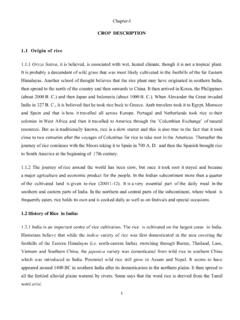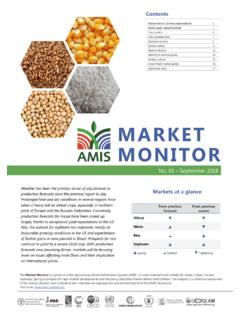Transcription of WHEAT - Farmer
1 1. WHEAT . THE CROP FOR ENSURING INDIAN FOOD SECURITY. 1. Prologue: The cultivation of WHEAT dates back to more than 5000 years back during the era of Indus valley civilization w h e r e the original species was Triticum Sphaerococcum popularly known a s Indian WHEAT has now disappeared and replaced by present day species- Triticum aestivum or the common Bread WHEAT , Triticum durum or the Macaroni WHEAT and the Triticum dicoccum or the Emmer WHEAT . During independence, the country was dependent on WHEAT import to meet the food demand of the country. Due to the lodging prone low yielding nature of Indian WHEAT under high fertility conditions, there remained a continuous need for a breakthrough in WHEAT production.
2 The WHEAT received u n d e r PL 480 agreement continued to be the main base on which the large population of India was dependent. It was finally the dream of Dr. Norman E. Borlaug, the father of green revolution during mid sixties that came true to materialize the spurt of the Green Revolution in the Indo gangetic plains by which India became a WHEAT surplus country from a deficient one. This led to the achievement of as hunger free world by then as India plays a major role in creating a global status of food security. The production level of WHEAT in India had a quantum jump from m i l l i o n tones from an area of million ha in 1950-51 t o more than 93 million tones from an area of about 30 million hectares during 2011-12.
3 Currently, India is second largest producer of WHEAT in the world after China with about 12% share in total world WHEAT production. Now, India is surplus and in a position to export WHEAT in the International Market and can earn foreign exchange. India has exported about 30 lakh tonnes of WHEAT worth ,490 crore during 2001 02. Three species of WHEAT namely, (i) T. aestivum, (ii) T. durum and (iii) T. dicoccum are being cultivated in the country , as per details given as under : % share of Species MAJOR GROWING AREAS. Production 2. 1. T. aestivum 95 % Uttar Pradesh, Punjab, Haryana, Rajasthan, Bihar, West Bengal, Assam, Parts of Madhya Pradesh, Himachal Pradesh, Jammu & Kashmir 2.
4 T. durum 4% Madhya Pradesh, Maharashtra, Gujarat, Southern Rajasthan and few locations in Punjab. 3. T. dicoccum 1% Karnataka, Maharastra & Tamil Nadu 3. 2. Area and production of WHEAT : Indian Scenario: WHEAT is grown in India in an area of about 30 Million ha. with a production of 93 Million tonnes. The normal National productivity is about tonnes/ha. The major WHEAT producing States are Uttar Pradesh, Punjab, Haryana, Madhya Pradesh, Rajasthan, Bihar, Maharashtra, Gujarat, Karnataka, West Bengal, Uttarakhand, Himachal Pradesh and Jammu & Kashmir. These States contribute about of total WHEAT production in the country.
5 Remaining States, namely, Jharkhand, Assam, Chhattisgarh, Delhi and other North Eastern States contribute only about % of the total WHEAT production in the country. The area, production and yield of WHEAT in different states of the country are as follows: Area, Production and Productivity of WHEAT in Major WHEAT growing States of India(2010-11). State Are Producti Yiel Sl. s a on d No Area(Lakh % to all India Production (lakh % to all India (Kg/H. Ha) MT) a). 1 Uttar Pradesh 3113. 0. 2 Madhya Pradesh 1757. 3 Punjab 4693. 0. 4 Haryana 4624. 0. 5 Rajasthan 2910. 6 Bihar 1948. 4. State Are Producti Yiel Sl.
6 S a on d No Area(Lakh % to all India Production (lakh % to all India (Kg/H. Ha) MT) a). 7 Maharashtra 1761. 8 Gujarat 3155. 9 Uttarakhand 2316. 10 Himachal Pradesh 1530. 11 West Bengal 2760. 12 Jammu & Kashmir 1535. 13 Karnataka 1094. 14 Chhatisgarh 1144. 15 Jharkhand 1642. 16 Assam 1179. 17 Delhi 4340. 18 Andhra Pradesh 1300. 19 Arunachal Pradesh 1595. 20 Nagaland 1712. 21 Orissa 1458. 5. Area Production Yiel Sl. State d No Area(Lakh % to all India Production (lakh % to all India (Kg/H. Ha) MT) a). 22 Sikkim 1023. 23 Manipur 24 Meghalaya 1791. 25 Tripura 2025. 26 D & N Haveli 2231. 27 Tamil Nadu 28 Others All India 2989.
7 6 0 0. It would be seen from above table that in terms of area, the state of Uttar Pradesh stands first followed by Madhya Pradesh, Punjab, Haryana, Rajasthan,Bihar, Maharashtra, Gujarat, , Himachal Pradesh, West Bengal, Karnataka and Jammu & Kashmir. In terms of production, again occupies first place followed by Punjab, Haryana, Madhya Pradesh, Rajasthan, Bihar, Maharashtra, Gujarat, West Bengal, Uttarakhand, Himachal Pradesh, Jammu & Kashmir and Karnataka. The contribution of these states in the production is about . The contribution of other States is minimal. As regards to the productivity, Punjab stands first (4531 Kg/ha.)
8 Followed by Haryana (4066 Kg/ha.), Uttar Pradesh (2691 ), Rajasthan (2481 Kg/ha.), West Bengal (2321 Kg/ha.), Gujarat (2294 Kg/ha.), Bihar (2143 Kg/ha.), Uttarakhand (1873 Kg/ha.), Madhya Pradesh (1753 Kg/ha.), Himachal Pradesh (1609 Kg/ha.), Maharashtra (1310 Kg/ha.), Jammu & Kashmir (1239 Kg/ha.) and Karnataka (855 Kg/ha.). 6. World Scenario The total area under WHEAT in the world is around million ha. with a production of million tonnes (2009- 10). The normal world productivity is 3039 The major WHEAT producing countries are China, India, USA, France, Russia, Canada, Australia, Pakistan, Turkey, UK, Argentina, Iran and Italy.
9 These countries contribute about 76% of the total world WHEAT production Area, Production and Yield of major crop growing countries(2009-10). Country Area(Lakh Production(lakh Yield(Kg/Ha % to World Production Ha) MT) ). China 473 1 5 9 9. India 290 0 0 7 7. Russian Federation 231 3 0 8. 298 1 4 9. France 744 7 2 7. Canada 278 8 8 6. Germany 780 6 0 8. Pakistan 265 6 3 7. Australia 160 7 6 3. Ukraine 309 3 6 3. Turkey 256 7 0 6. Kazakhstan 119 9 2 0. 792 4 9 7. Iran 202 7 5 9. Country Area(Lakh Production(lakh Yield(Kg/Ha % to World Production Ha) MT) ). 7. Poland 417 6 0 3. Egypt 644 2 3 8.
10 Argentina 174 5 3 7. Italy 353 6 1 2. Romania 243 1 3 0. Spain 267 8 4 2. Syria 257 7 2 5. Bangladesh 214 9. World 303 4 9 0. India stands first in area and second in production next to China in the world . The India's share in world WHEAT area is about , whereas it occupies % share in the total world WHEAT production. There is hardly any scope for expansion of area under WHEAT . The main emphasis would be on increasing the productivity of WHEAT by adopting the improved cultivation practices. 8. Gap in Yield with other countries Country Yield(Kg/Ha) Yield Gap (-/+ Kg/Ha over Indian Productivity).











